A Novel Acoustic Liquid Level Determination Method for Coal Seam Gas Wells Based on Autocorrelation Analysis
Abstract
:1. Introduction
2. Principles of Acoustic Liquid Level Determination
3. Development of an Acoustic Liquid Level Determination Method
3.1. Acoustic Velocity in Annulus
3.1.1. Modeling of Annulus Temperature
3.1.2. Modeling of Annulus Pressure
3.2. Acoustic Travel Time in Annulus
3.2.1. Characteristics Analysis of Test Acoustic Signal
3.2.2. Principles of Autocorrelation Analysis for Test Acoustic Signal
3.2.3. Estimation for ACF of Test Acoustic Signal
3.3. Determination of Acoustic Liquid Level
- Divide the well into n cells with the same length Δz in the depth direction;
- The pressure and temperature of the first cell are equal to that measured at the wellhead;
- For the cell i, a value of annulus pressure is assumed.
- Calculate the annulus temperature ;
- Calculate the annulus pressure Pci;
- Check if . If so, go to next cell. If not, assume a new value of annulus pressure and go back to step 2.
- Calculate the acoustic velocity Wci;
- Calculate the acoustic travel-time ;
- Calculate the cumulative travel time from surface to current depth ;
- Repeat step 3 to step 9, until ;
- The depth of the liquid level is equal to zi = i*Δz.
4. Acoustic Liquid Level Detection Experiments
4.1. Discriptions of the Experimental Devices
4.2. Experimental Schemes
4.3. Experimental Results and Analysis
4.3.1. Acoustic Signal Feature Extraction and Comparison Analysis under Different Annulus Pressures
4.3.2. Acoustic Signal Feature Extraction and Comparison Analysis under Different Noise Levels
5. Field Application and Analysis
5.1. Description of Field Test
5.2. Results and Analysis
6. Conclusions
- In the laboratory experiment, a comparative study was carried out to discuss the extraction ability and accuracy between the autocorrelation method and FFT under different sound pressures and noise levels. Compared to FFT-based filtering algorithm, the Crest Factor increases 1.88 and the maximal measurement error reduces from 1.04% to 0.47% under non-nosise conditoin when the autocorrelation method is adopted. In addition, the latent periodic characteristic of the reflected signal can be extracted with the autocorrelation method when the noise is larger than 1.42 Pa, which can not be obtained in FFT.
- In field experiments, the obtained Crest Factors are 3.01 and 5.86, respectively, using the two methods, which shows that the novel approach make liquid level reflection signal be better recognized by the testing system.
- Therefore, the new method can not only provide the theoretical guidance for the testing methods but also have the field application value on accurately and precisely detecting the liquid level of CSG wells.
Acknowledgments
Author Contributions
Conflicts of Interest
References
- Zhang, L.; Zhang, H.; Guo, H. A case study of gas drainage to low permeability coal seam. Int. J. Min. Sci. Technol. 2017, 27, 687–692. [Google Scholar] [CrossRef]
- Cao, Y.; Zhang, J.; Zhai, H.; Fu, G.; Tian, L.; Liu, S. CO2 gas fracturing: A novel reservoir stimulation technology in low permeability gassy coal seams. Fuel 2017, 203, 197–207. [Google Scholar] [CrossRef]
- Karacan, C.O. Best practice guidance for effective methane drainage and use in coal mines—United Nations Economic Commission for Europe Energy Series No: 31. Int. J. Coal Geol. 2014, 121, 35–36. [Google Scholar] [CrossRef]
- Qin, Y.; Wei, C.; Wang, G.X.; Rudolph, V.; Fu, X.; Wu, C. Fundamental studies and practice for enhanced coalbed methane technologies in China: A review. In Proceedings of the APCBM 2008 Symposium, Brisbane, Australia, 22–24 September 2008; pp. 1–31. [Google Scholar]
- Shen, J.; Qin, Y.; Wang, G.X.; Fu, X.; Wei, C.; Lei, B. Relative permeabilities of gas and water for different rank coals. Int. J. Coal Geol. 2011, 86, 266–275. [Google Scholar] [CrossRef]
- Schraufnagel, R.A.; McBane, R.A. Coalbed methane production. In Proceedings of the Annual Technical Conference and Exhibition, New Orleans, LA, USA, 25–28 September 1994; pp. 1–14. [Google Scholar]
- Durucan, S.; Ahsanb, M.; Shia, J.Q. Matrix shrinkage and swelling characteristics of European coals. Energy Procedia 2009, 1, 3055–3062. [Google Scholar] [CrossRef]
- Mitchell, T.R.; Leonardi, C.R. Micromechanical investigation of fines liberation and transport during coal seam dewatering. J. Nat. Gas Sci. Eng. 2016, 35, 1101–1120. [Google Scholar] [CrossRef]
- Tao, S.; Wang, Y.B.; Tang, D.Z.; Xu, H.; Lv, Y.M.; He, W.; Li, Y. Dynamic variation effects of coal permeability during the coalbed methane development process in the Qinshui Basin, China. Int. J. Coal Geol. 2012, 93, 16–22. [Google Scholar] [CrossRef]
- Lieberman, S. Automated continuous fluid level monitoring. In Proceedings of the SPE Production Operations Symposium, Oklahoma City, OK, USA, 16–19 April 2005; pp. 1–18. [Google Scholar]
- Palmer, I. Permeability changes in coal: Analytical modeling. Int. J. Coal Geol. 2009, 77, 119–126. [Google Scholar] [CrossRef]
- Li, P.; Chen, S.; Cai, Y.; Chen, J.; Li, J. Accurate TOF measurement of ultrasonic signal echo from the liquid level based on a 2-D image processing method. Neurocomputing 2016, 175, 47–54. [Google Scholar] [CrossRef]
- Schubert, J.J.; Wright, J.C. Early kick detection through liquid level monitoring in the wellbore. In Proceedings of the 1998 IADC/SPE Drilling Conference, Dallas, TX, USA, 3–6 March 1998; pp. 1–7. [Google Scholar]
- Godbey, J.K.; Ballard, B.G. Automatic Liquid Level Monitor. U.S. Patent 140410, 14 April 1980. [Google Scholar]
- McCoy, J.N.; Rowlan, O.L.; Becker, D.; Podio, A.L. Applications of acoustic liquid level measurements in gas wells. In Proceedings of the 2006 SPE Annual Technical Conference and Exhibition, San Antonio, TX, USA, 24–27 September 2006; pp. 1–16. [Google Scholar]
- Peng, G.L.; He, J.; Yang, S.P.; Zhou, W.Y. Application of the fiber-optic distributed temperature sensing for monitoring the liquid level of producing oil wells. Measurement 2014, 58, 130–137. [Google Scholar] [CrossRef]
- McCoy, J.N.; Rowlan, O.L.; Becker, D.; Podio, A.L. Advanced techniques for acoustic liquid level determination. In Proceedings of the Petroleum Society’s Canadian International Petroleum Conference, Calgary, AB, Canada, 11–13 June 2002; pp. 1–14. [Google Scholar]
- Rowlan, O.L.; McCoy, J.N.; Becker, D.; Podio, A.L. Advanced techniques for acoustic liquid-level determination. In Proceedings of the SPE Production and Operations Symposium, Oklahoma City, OK, USA, 22–25 March 2003; pp. 1–12. [Google Scholar]
- Taylor, C.; Rowlan, L.; McCoy, J. Acoustic techniques to monitor and troubleshoot gas-lift wells. In Proceedings of the SPE Western North American and Rocky Mountain Joint Regional Meeting, Denver, CO, USA, 16–18 April 2014; pp. 1–10. [Google Scholar]
- Clarkson, C.; Bustin, M. Coalbed methane: Current evaluation methods, future technical challenges. In Proceedings of the SPE Unconventional Gas Conference, Pittsburgh, PA, USA, 23–25 February 2010; pp. 1–13. [Google Scholar]
- Bhargava, V.; Sethi, A.; Singh, S.; Chellani, I. A case study—determination of accurate liquid level and its applications in CBM wells. In Proceedings of the SPE Oil and Gas India Conference and Exhibition, Mumbai, India, 24–26 November 2015; pp. 1–8. [Google Scholar]
- McCoy, J.; Podio, A.L.; Rowlan, L.; Garrett, M. Acoustic foam depression tests. In Proceedings of the the 48th Annual Technical Meeting of the Petroleum Society, Calgary, AB, Canada, 8–11 June 1997; pp. 1–13. [Google Scholar]
- Han, G.Q.; Ling, K.G.; Zhang, H. Smart de-watering and production system through real-time water level surveillance for Coal-Bed Methane wells. J. Nat. Gas Sci. Eng. 2016, 31, 769–778. [Google Scholar] [CrossRef]
- The Application of the Realtime Annulus Liquid Level Determation System. Available online: http://www.gtpetro.com/unitermtech/gtp_unitech_lianxuyemian.html (accessed on 12 September 2015).
- Shi, J.Q.; Durucan, S. A model for changes in coalbed permeability during primary and enhanced recovery. SPE Reserv. Eval. Eng. 2005, 8, 291–299. [Google Scholar] [CrossRef]
- Ernest, J.H.; Evans, D.M.; Fasching, G.E. Wireless Remote Liquid Level Detector and Indicator for Well Testing. U.S. Patent 569087, 18 June 1985. [Google Scholar]
- Ramy, H.J. Wellbore heat transmission. J. Pet. Technol. 1962, 14, 427–435. [Google Scholar] [CrossRef]
- Hasan, A.R.; Kabir, C.S. Heat transfer during two phase flow in wellbore: Part 1-formation temperature. In Proceedings of the 66th Annual Technical Conference and Exhibition of the Society of Petroleum Engineers, Dallas, TX, USA, 6–9 October 1991; pp. 469–478. [Google Scholar]
- Adams, A.J. How to design for annulus fluid heat-up. In Proceedings of the 66th Annual Technical Conference and Exhibition of the Society of Petroleum Engineers, Dallas, TX, USA, 6–9 October 1991; pp. 529–540. [Google Scholar]
- Guan, Z.; Zhang, B.; Wang, Q.; Liu, Y.; Xu, Y.; Zhang, Q. Design of thermal-insulated pipes applied in deepwater well to mitigate annular pressure build-up. Appl. Therm. Eng. 2016, 98, 129–136. [Google Scholar] [CrossRef]
- Liu, J.; Fan, H.; Peng, Q.; Deng, S.; Kang, B.; Ren, W. Research on the prediction model of annular pressure buildup in subsea wells. J. Nat. Gas Sci. Eng. 2015, 27, 1677–1683. [Google Scholar] [CrossRef]
- Savidge, J.L.; Starling, K.E.; McFall, R.L. Sound speed of natural gas. In Proceedings of the SPE Gas Technology Symposium, Dallas, TX, USA, 13–15 June 1988. [Google Scholar]
- Ohno, J.; Yashiro, H. Method and Apparatus for Measuring Water Level in a Well. U.S. Patent 4621264A, 4 November 1986. [Google Scholar]
- Thomas, L.; Hankinson, R.; Phillips, K. Determination of acoustic velocities for natural gas. J. Pet. Technol. 1970, 22, 889–895. [Google Scholar] [CrossRef]
- Starling, K.E.; Savidge, J.L. Compressibility Factors of Natural Gas and Other Related Hydrocarbon Gases, 2nd ed.; American Gas Association: Washington, DC, USA, 1992. [Google Scholar]
- Aly, F.A.; Lee, L.L. Self-consistent equations for calculating the ideal gas heat capacity, enthalpy, and entropy. Fluid Phase Equilib. 1981, 6, 169–179. [Google Scholar] [CrossRef]
- Ahmadi, P.; Chapoy, A.; Tohidi, B. Density, speed of sound and derived thermodynamic properties of a synthetic natural gas. J. Nat. Gas Sci. Eng. 2017, 40, 249–266. [Google Scholar] [CrossRef]
- Alive, I.N.; Alhanati, F.J.S.; Shoham, O. A unified model for predicting flowing temperature distribution in wellbores and pipelines. SPE Prod. Eng. 1992, 11, 363–367. [Google Scholar]
- Moss, J.T.; White, P.D. How to calculate temperature profiles in a water-injection well. Oil Gas J. 1959, 57, 174. [Google Scholar]
- Sagar, R.; Doty, D.R.; Schmidt, Z. Predicting temperature profiles in a flowing well. SPE Prod. Eng. 1991, 11, 441–448. [Google Scholar] [CrossRef]
- Jin, Y.; Haixiong, T.; Zhengli, L.; Liping, Y.; Xiaolong, H.; De, Y.; Ruirui, T. Prediction model of casing annulus pressure for deepwater. Pet. Explor. Dev. 2013, 40, 661–664. [Google Scholar]
- Zheng, X.; Duan, C.; Yan, Z.; Ye, H.; Wang, Z.; Xia, B. Equivalent circulation density analysis of geothermal well by coupling temperature. Energies 2017, 10, 268. [Google Scholar] [CrossRef]
- Fattah, S.A.; Zhu, W.P.; Ahmad, M.O. An approach to formant frequency estimation at low signal-to-noise ratio. In Proceedings of the 2007 IEEE International Conference on Acoustics, Speech and Signal Processing (ICASSP 2007), Honolulu, HI, USA, 15–20 April 2007; pp. 469–472. [Google Scholar]
- Fattah, S.A.; Zhu, W.P.; Ahmad, M.O. An approach to ARMA system identification at a very low signal-to-noise ratio. In Proceedings of the IEEE International Conference on Acoustics, Speech and Signal Processing, Philadelphia, PA, USA, 18–23 March 2005; pp. 113–116. [Google Scholar]
- Gao, Y.; Brennan, M.J.; Joseph, P.F.; Muggleton, J.M.; Hunaidi, O. A model of the correlation function of leak noise in buried plastic pipes. J. Sound Vib. 2004, 277, 133–148. [Google Scholar] [CrossRef]
- Cai, B.; Liu, H.; Xie, M. Bayesian networks in fault diagnosis. IEEE Trans. Ind. Inform. 2017, 13, 2227–2240. [Google Scholar] [CrossRef]
- Cai, B.; Liu, H.; Xie, M. A real-time fault diagnosis methodology of complex systems using object-oriented Bayesian networks. Mech. Syst. Signal Process. 2017, 80, 31–44. [Google Scholar] [CrossRef]
- Nair, M.V.D.; Giofré, R.; Colantonio, P.; Giannini, F. Sequential asymmetric superposition windowing for Crest Factor Reduction and its effects on Doherty power amplifier. In Proceedings of the 2015 Integrated Nonlinear Microwave and Millimetre-Wave Circuits Workshop, Taormina, Italy, 1–2 October 2015; pp. 1–3. [Google Scholar]
- Khasanov, M.M.; Krasnov, V.; Khabibullin, R.; Pashali, A.; Semenov, A.A. New method for fluid level depression test interpretation based on modern multiphase flow calculation techniques. In Proceedings of the Society of Petroleum Engineers, Barcelona, Spain, 14–17 June 2010; pp. 1–10. [Google Scholar]
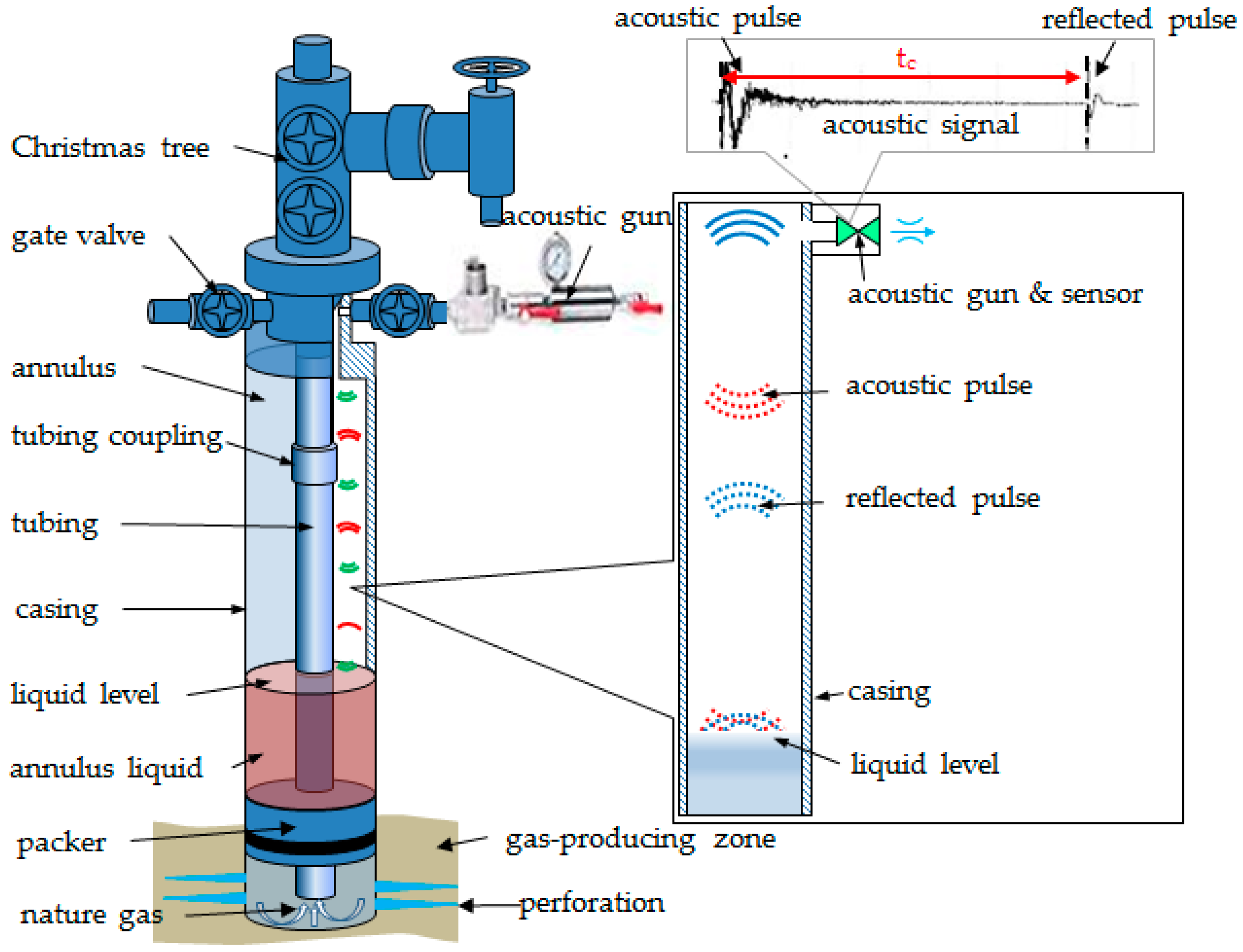
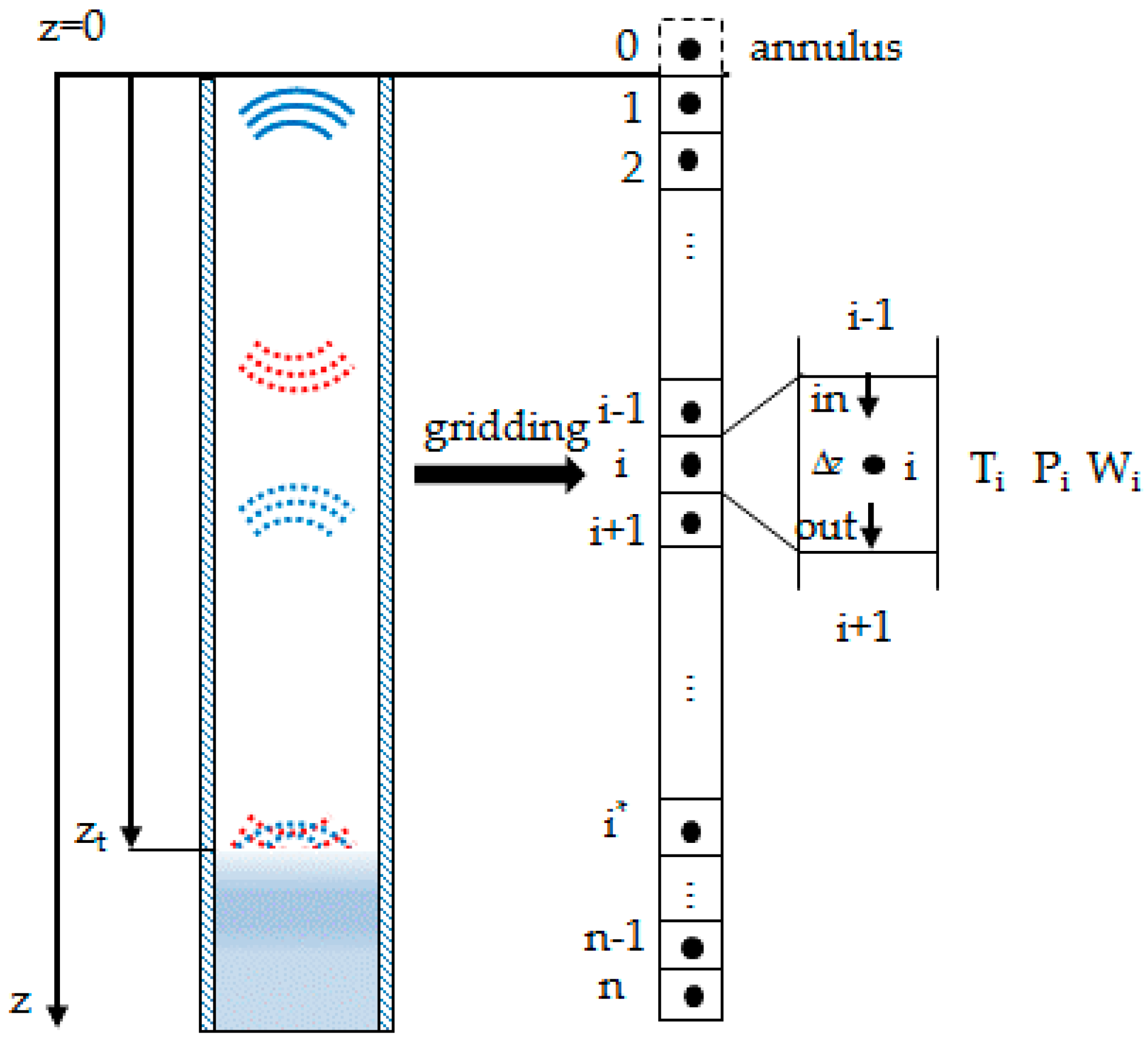

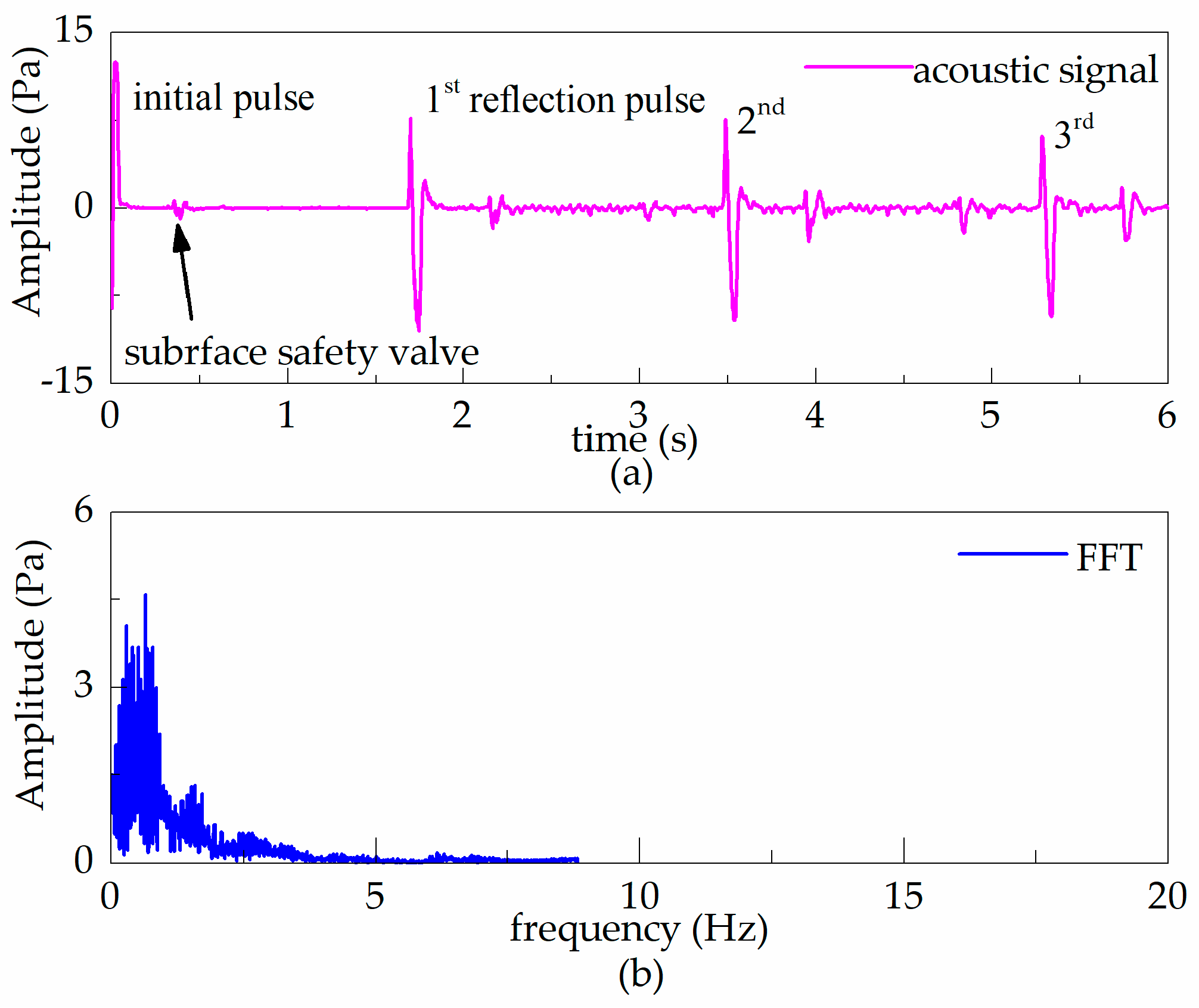

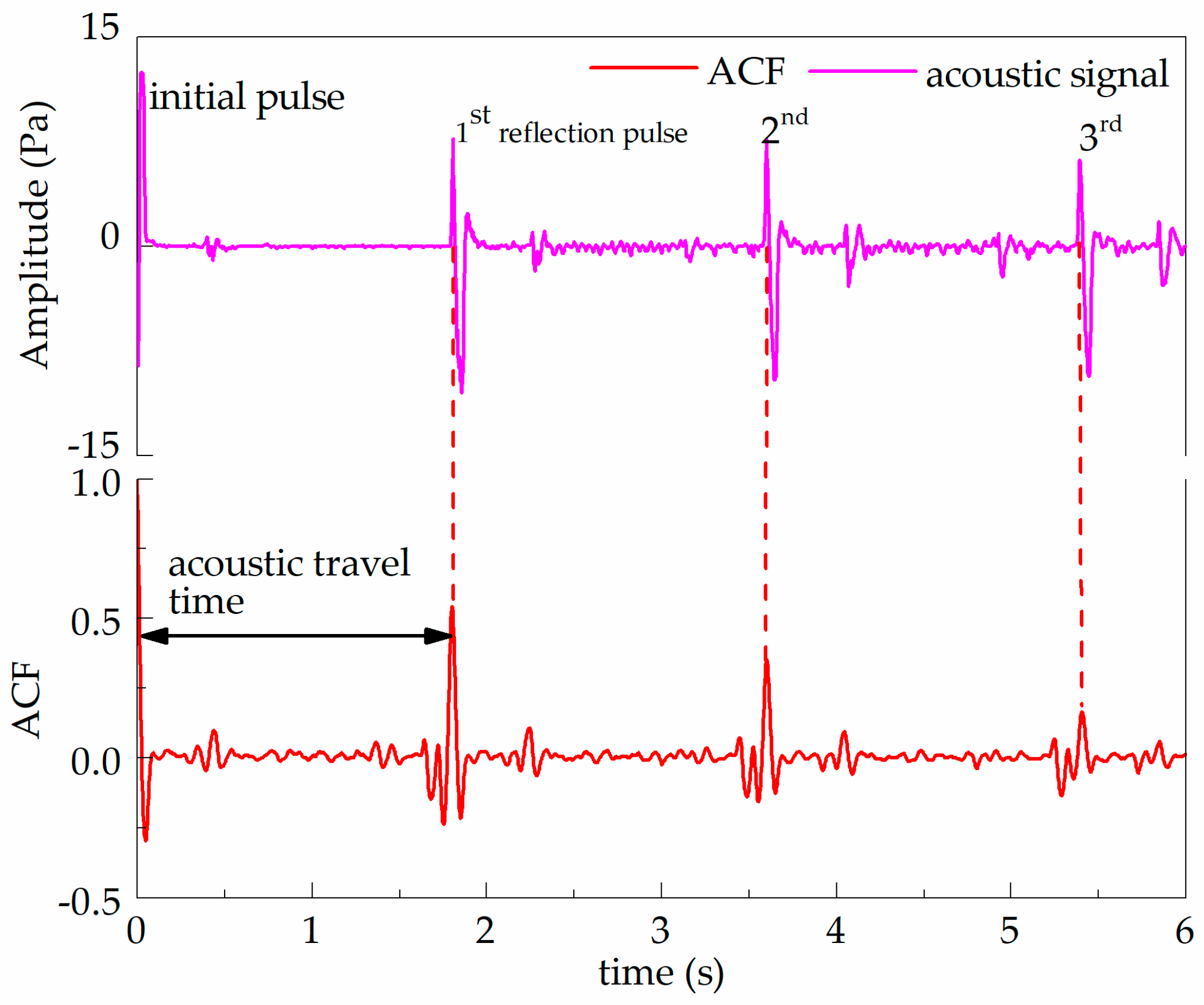

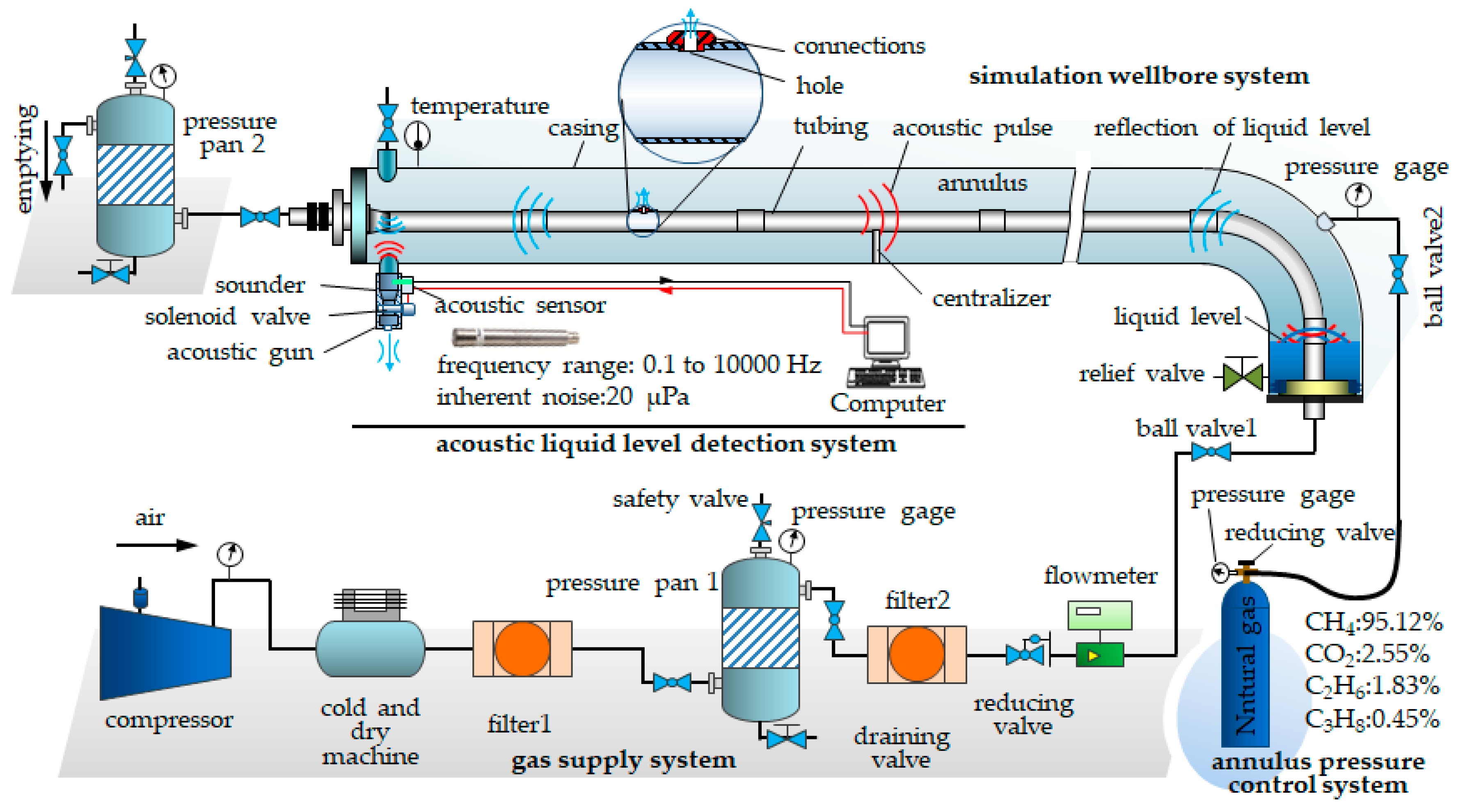
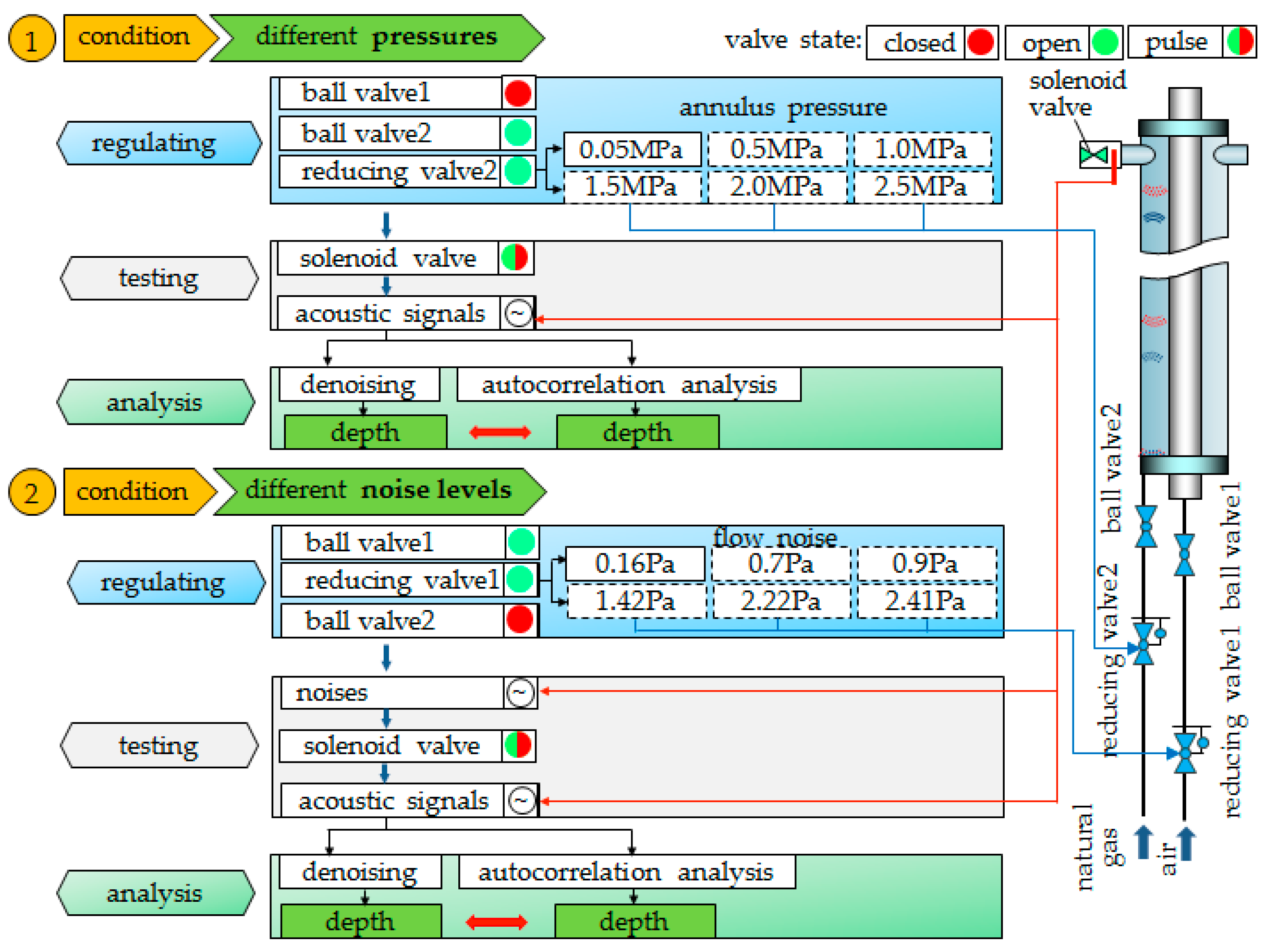

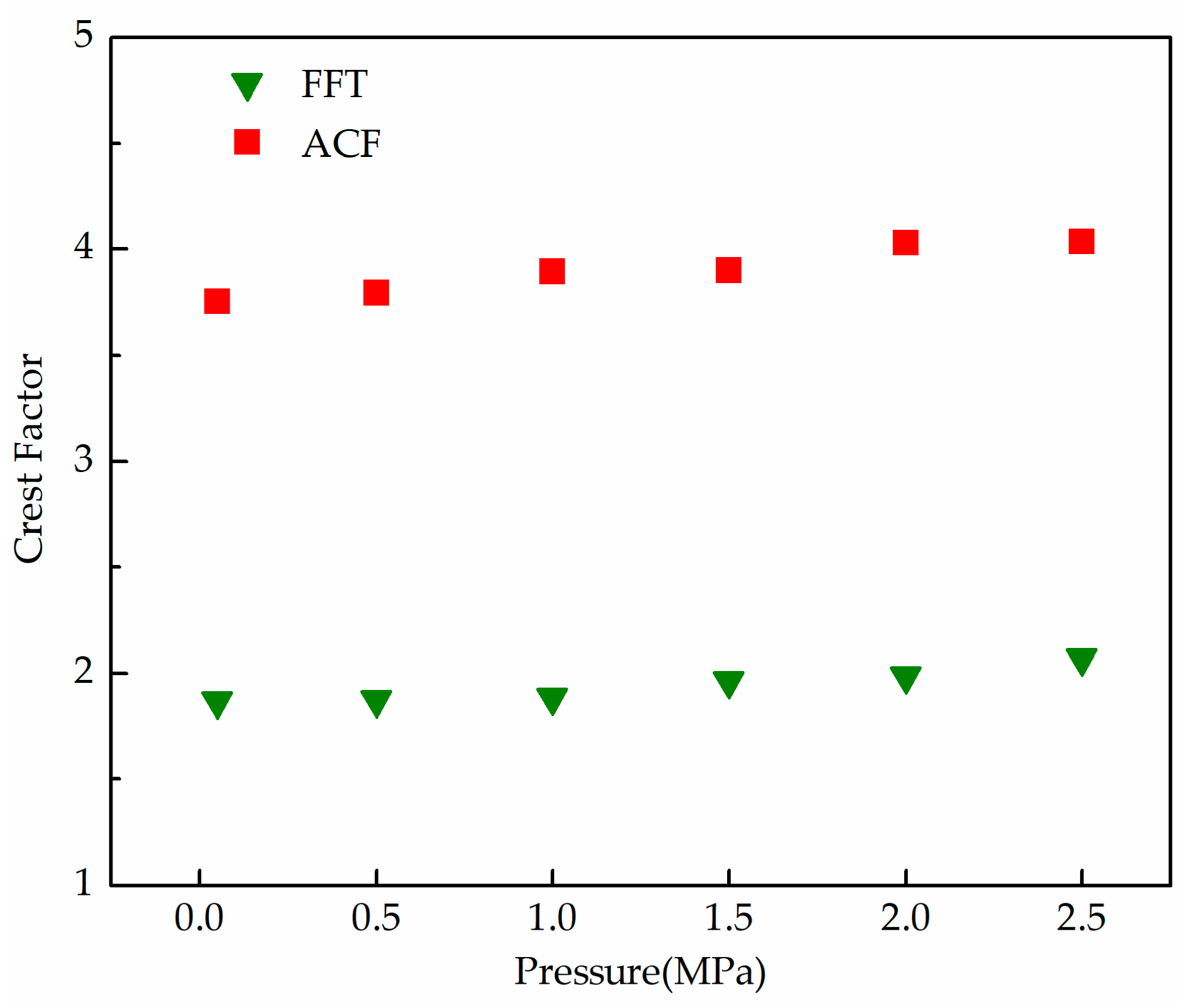

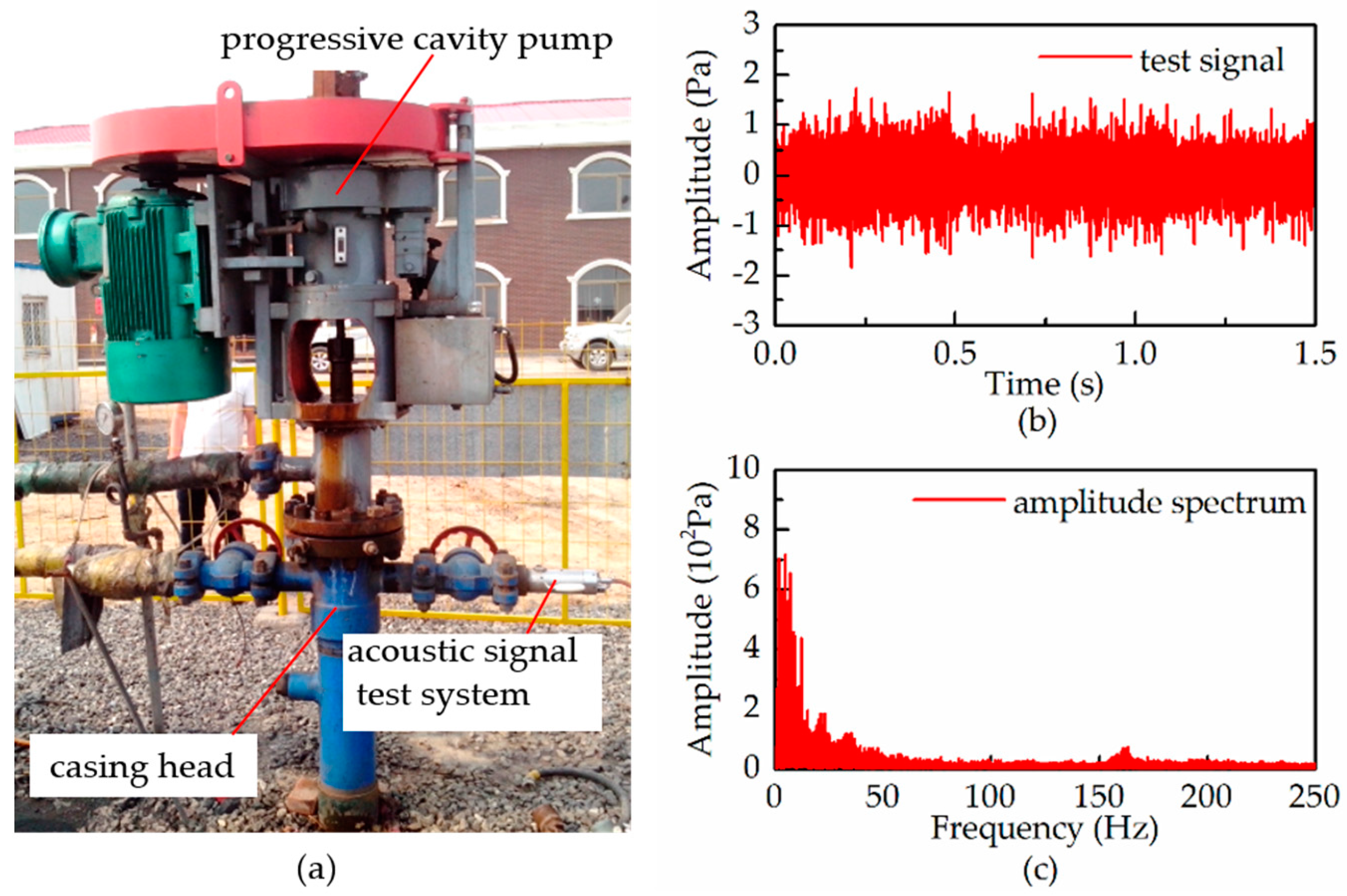


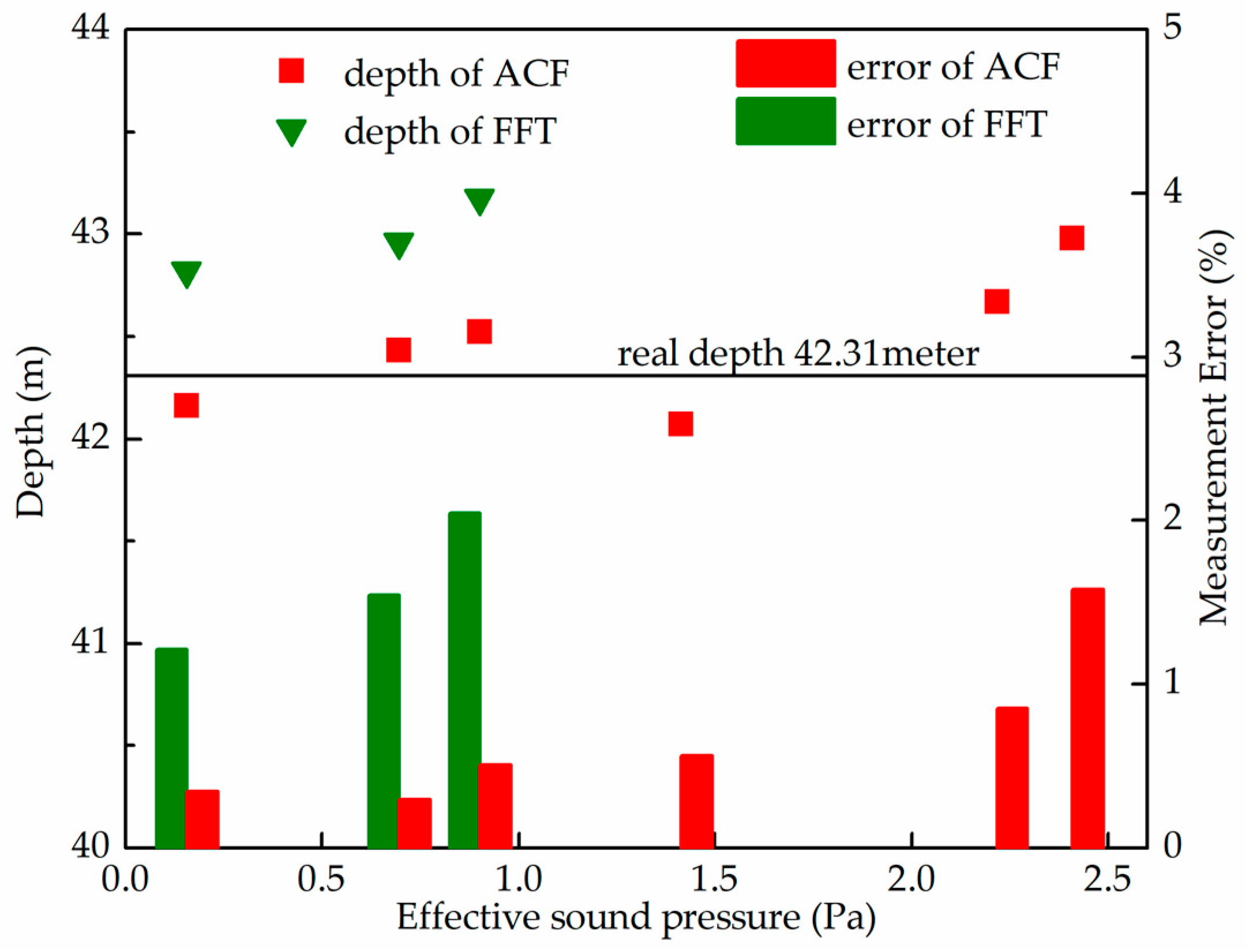

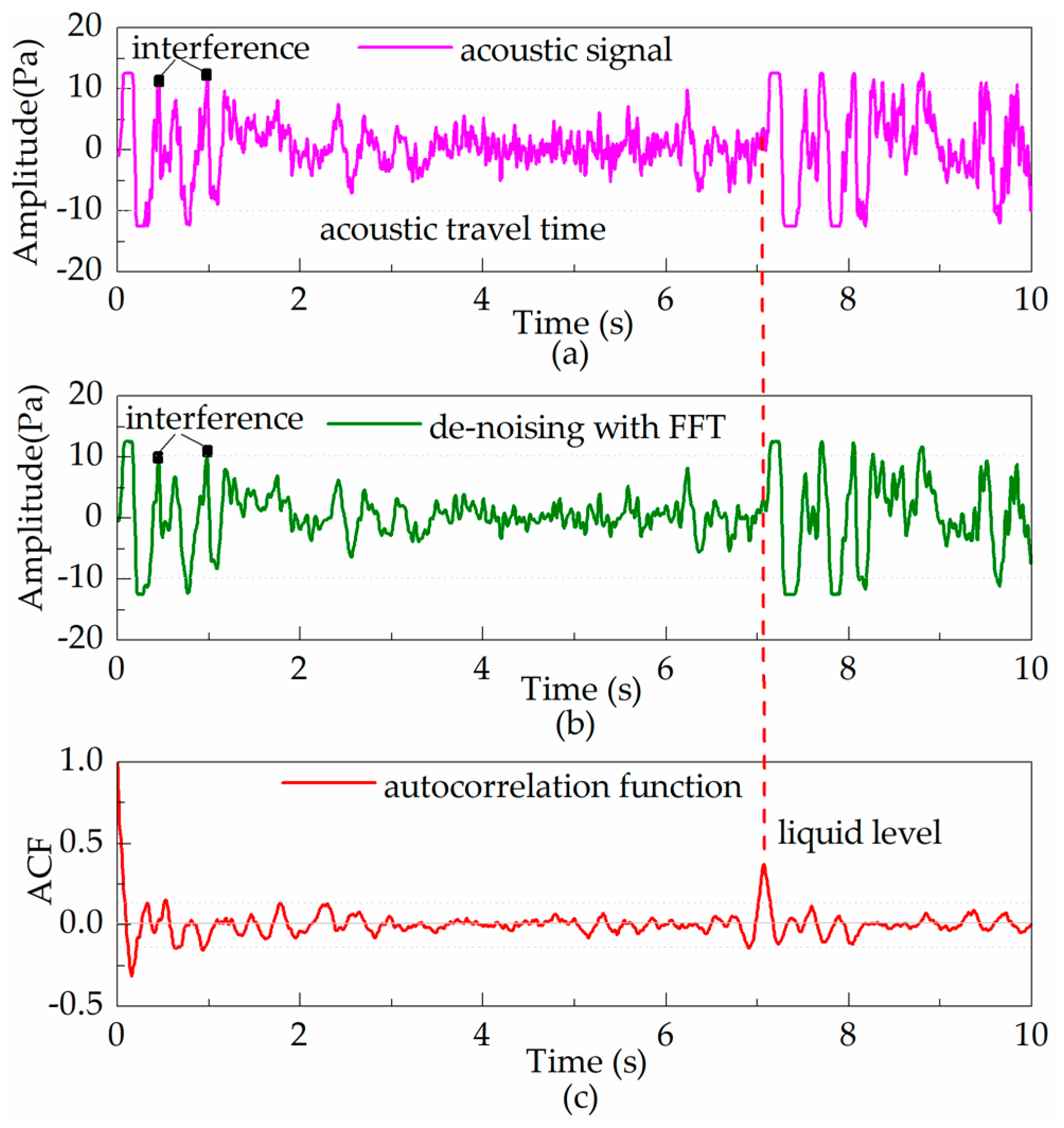
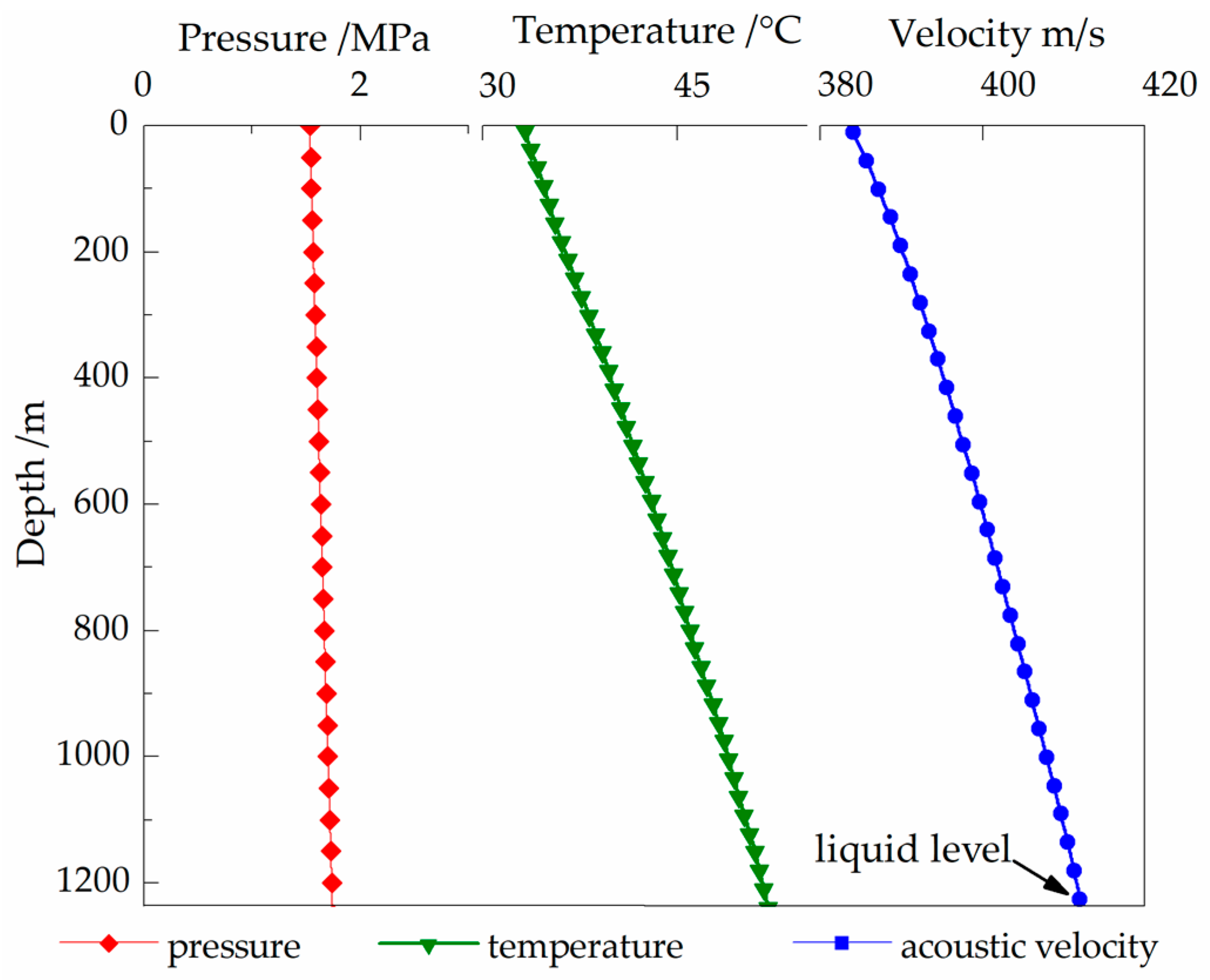
| Subsystem | Item | Parameter |
|---|---|---|
| Simulation wellbore | tubing specifications | Φ 73.00 × 5.51 mm |
| casing specifications | Φ 139.70 × 6.20 mm | |
| length of annulus | 42.13 m | |
| Acoustic liquid level detection | pressure range | 0.00 to 57.30 kPa |
| frequency range | 0.10 to 10,000 Hz | |
| Annulus pressure control system | gas components | 95.12% CH4, 2.55% CO2, 1.83% C2H6 and 0.45% C3H8 |
| Gas supply system | maximum flow | 1000 stand m3/day |
| Annulus Pressure (MPa) | Amplitude (Pa) | |||
|---|---|---|---|---|
| 2.50 | 14.70 | 10.51 | 14.42 | 0.59 |
| 2.00 | 12.66 | 9.11 | 12.50 | 0.53 |
| 1.50 | 10.21 | 7.60 | 10.08 | 0.52 |
| 1.00 | 8.00 | 6.45 | 7.90 | 0.51 |
| 0.50 | 5.20 | 3.82 | 5.10 | 0.49 |
| 0.05 | 4.24 | 3.01 | 4.08 | 0.48 |
| Item | Parameters |
|---|---|
| diameter of tubing (mm) | Φ73.00 × 5.51 |
| diameter of casing (mm) | Φ139.70 × 6.20 |
| formation temperature (°C) | 78.23 |
| geothermal gradient (°C/100 m) | 3.67 |
| setting depth of pressure gauge (m) | 1340.17 |
| tubing temperature (°C) | 33.27 |
| annulus temperature (°C) | 30.20 |
| annulus pressure (MPa) | 1.53 |
| density of annular fluid (g/cm3) | 0.95 |
| producing of gas (stand m3/day) | 3000.00 |
© 2017 by the authors. Licensee MDPI, Basel, Switzerland. This article is an open access article distributed under the terms and conditions of the Creative Commons Attribution (CC BY) license (http://creativecommons.org/licenses/by/4.0/).
Share and Cite
Zhang, X.; Fan, J.; Wu, S.; Liu, D. A Novel Acoustic Liquid Level Determination Method for Coal Seam Gas Wells Based on Autocorrelation Analysis. Energies 2017, 10, 1961. https://doi.org/10.3390/en10121961
Zhang X, Fan J, Wu S, Liu D. A Novel Acoustic Liquid Level Determination Method for Coal Seam Gas Wells Based on Autocorrelation Analysis. Energies. 2017; 10(12):1961. https://doi.org/10.3390/en10121961
Chicago/Turabian StyleZhang, Ximing, Jianchun Fan, Shengnan Wu, and Di Liu. 2017. "A Novel Acoustic Liquid Level Determination Method for Coal Seam Gas Wells Based on Autocorrelation Analysis" Energies 10, no. 12: 1961. https://doi.org/10.3390/en10121961
APA StyleZhang, X., Fan, J., Wu, S., & Liu, D. (2017). A Novel Acoustic Liquid Level Determination Method for Coal Seam Gas Wells Based on Autocorrelation Analysis. Energies, 10(12), 1961. https://doi.org/10.3390/en10121961




